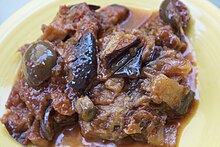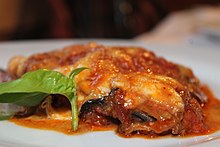List of Italian foods and drinks
This article needs additional citations for verification. (May 2012) |
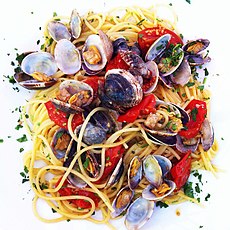 |
| Italian cuisine |
|---|
|
|



This is a list of Italian dishes and foods. Italian cuisine has developed through centuries of social and political changes, with roots as far back as the 4th century BC. Italian cuisine has its origins in Etruscan, ancient Greek, and ancient Roman cuisines. Significant changes occurred with the discovery of the New World and the introduction of potatoes, tomatoes, bell peppers and maize, now central to the cuisine, but not introduced in quantity until the 18th century.[1][2] The cuisine of Italy is noted for its regional diversity,[3][4][5] abundance of difference in taste, and is known to be one of the most popular in the world,[6] with influences abroad.[7]
Pizza and spaghetti, both associated with the Neapolitan traditions of cookery, are especially popular abroad, but the varying geographical conditions of the twenty regions of Italy, together with the strength of local traditions, afford a wide range of dishes.
Dishes and foods
The cuisine of Italy has many unique dishes and foods.
Zuppe e salse ("soups and sauces")
- Acquacotta – an Italian soup that was originally a peasant food. Historically, its primary ingredients were water, stale bread, onion, tomato and olive oil,[8] along with various vegetables and leftover foods that may have been available.[9][10]
- Agghiotta di lumache (Sicilian snail soup)
- Agliata
- Agrodolce
- Bagna càuda
- Bagnun
- Bomba calabrese
- Boreto
- Brodetto
- Brovada
- Capra e fagioli
- Fondue
- Garmugia
- Ginestrata
- Gremolata
- Maccu
- Minestra di ceci
- Minestra di fagioli
- Minestra di pasta con pesce
- Minestrone
- Mostarda di frutta (sometime also called mostarda)
- Neapolitan ragù
- Panada
- Pancotto
- Pasta e fagioli
- Pesto
- Pesto alla trapanese
- Ragù – a meat-based sauce commonly served with pasta
- Ragù alla bolognese
- Ragù alla salsiccia
- Ribollita
- Risi e bisi
- Salsa verde
- Sciusceddu
- Stracciatella
- Sugo al pomodoro
- Zuppa alla pavese
- Zuppa alla valpellinese
Pane ("bread")


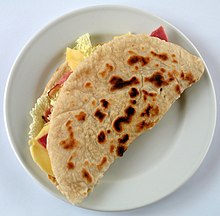
- Bozza pratese
- Bruschetta
- Casatiello
- Ciabatta – an Italian white bread made from wheat flour, water, salt, olive oil, and yeast, created in 1982 by a baker in Adria, Veneto, Italy, in response to popularity of French baguettes
- Ciaccino
- Ciriola – typical bread of Rome
- Colomba di Pasqua
- Coppia ferrarese
- Cornetto
- Crescentina
- Crescia
- Crocchè
- Farinata
- Ficattola
- Filone
- Focaccia
- Fragguno
- Grissini torinesi
- Michetta – typical bread of Milan
- Moddizzosu
- Muffuletta
- Neccio
- Pandoro
- Pane carasau
- Pane casareccio di Genzano
- Pane con le patate
- Pane di Altamura
- Pane di Genzano (Lazio)
- Pane di Laterza
- Pane di mais (lit. 'cornbread')
- Pane di Matera
- Pane di Solina, pagnotte di Solina
- Panella
- Pane nobile di Guardiagrele
- Pane pugliese
- Pane parruozzo
- Pane rustico – traditional crusty peasant bread
- Pane toscano – without salt
- Panettone
- Panino
- Panonta
- Penia
- Piadina
- Pita – typical bread of Catanzaro
- Rosetta – typical bread of Rome
- Scaccia
- Tarallo
- Testarolo
- Tigella
- Tortano
- Torta salata
Common pizzas

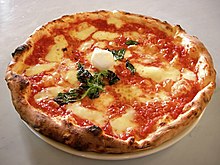
- Calzone – folded over dough usually filled with ricotta and other ingredients
- Fiadone – from Chieti; a dough of risen eggs and cheese, baked in a thin pastry shell
- Focaccia al rosmarino – a pizza based on rosemary and olive oil, sometimes served with prosciutto, usually served as appetizer
- Panzerotto
- Pizza ai frutti di mare – an Italian seafood pizza that may be served with scampi, mussels or squid[11]
- Pizza ai funghi e salsiccia – pizza with mushroom, sausage or boscaiola, and mozzarella, with or without tomato
- Pizza ai quattro formaggi (lit. 'four cheese pizza') – with four different cheeses, typically Parmesan, Gorgonzola, ricotta and mozzarella (sometimes melted together, sometimes in sectors), with (rossa, red) or without tomato sauce (bianca, white)[12]
- Pizza al taglio (Italian for pizza by the slice — lit. 'by the cut')[13] – a variety of pizza baked in large rectangular trays,[14] and generally sold in rectangular or square slices by weight, with prices marked per kilogram or per 100 grams.[15] This type of pizza was invented in Rome, Italy, and is common throughout Italy.[16]
- Pizza al tegamino (or pizza al padellino) – a small pan pizza common to Piedmont
- Pizza capricciosa – with tomato, mozzarella, mushrooms, artichokes, black and green olives
- Pizza di Pasqua (lit. 'Easter pizza') – a rustic pizza with cheese and pepper from the Teramo area
- Pizza fritta (lit. 'fried pizza') – shallow-fried pizza[17]
- Pizza Margherita – tomato and mozzarella
- Pizza marinara – tomato, oregano and garlic
- Pizza napoletana (lit. 'Neapolitan pizza') – tomato, mozzarella and anchovy
- Pizza pugliese – tomato, mozzarella and onions
- Pizza quattro stagioni (lit. 'four seasons pizza') – based on tomato and divided in four sectors, one for each season:
- Pizza romana (lit. 'Roman pizza') – tomato, mozzarella, capers and anchovy
- Pizza scima
- Pizza siciliana (lit. 'Sicilian pizza') and sfincione / sfinciuni) – tomato, mozzarella, capers, olive and anchovy
Pasta varieties

- Agnolotti
- Bavette
- Bigoli
- Bucatini
- Cannelloni
- Capellini
- Cappelletti
- Conchiglie
- Corzetti
- Crespelle
- Culurgiones
- Chitarra
- Ditalini
- Eliche
- Farfalle
- Festoni
- Fettuccine
- Filatieddi
- Fusilli
- Garganelli
- Gnocchi
- Gnocchi di semolino – dumplings made with semolina flour[18]
- Lasagna
- Lasagnette
- Lasagnotte
- Linguine
- Lumache
- Macaroni
- Malloreddus (Sardinian pasta)
- Maltagliati
- Marille
- Marrubini
- Offelle
- Orecchiette
- Orzo
- Paccheri
- Paglia e fieno
- Pansotti
- Panzarotti
- Pappardelle
- Passatelli
- Patacucci
- Penne
- Perciatelli
- Pici
- Pinzillacchere
- Pizzoccheri
- Rigatoni
- Spaghetti
- Spaghetti alla chitarra
- Stelline – means "little stars" in Italian.[19] The pasta is shaped like small stars.[19]
- Strangozzi
- Strascinati
- Strozzapreti
- Tacconi
- Tagliarini
- Tagliatelle
- Testaroli – sometimes served with pesto[20]
- Tonnarelli
- Tortelli
- Tortellini
- Tortelloni
- Trenette
- Trofie
- Trottole
- Vermicelli
- Ziti
Pasta dishes



- Bucatini all'amatriciana, bucatini alla sorrentina, bucatini ai porcini
- Cacio e pepe
- Cannelloni al ragù, cannelloni ai carciofi
- Carbonara
- Casoncelli
- Ciceri e tria
- Cjarsons
- Fettuccine Alfredo
- Gnocchi alla romana
- Lasagna
- Gnocchi carrati
- Linguine alle vongole – with clam sauce
- Maccheroni alla molinara
- Orecchiette con le cime di rapa
- Pansotti alla genovese – a type of huge ravioli
- Pasta â Paolina
- Pasta al pesto
- Pasta alla gricia
- Pasta alla Norma
- Pasta all'Ortolana
- Pasta allo scarpariello
- Pasta ca nunnata
- Pasta chi Vrocculi Arriminati
- Pasta con i peperoni cruschi
- Pasta con le sarde
- Pasta e ceci
- Pasta mollicata
- Pasta 'ncasciata
- Pavese agnolotti – a type of egg-based stuffed pasta served dry, with a sauce based on Pavese stew,[21] or in goose broth.[22][23]
- Penne all'arrabbiata
- Pisarei e faśö
- Ravioli
- Rigatoni con la pajata, rigatoni al forno con salsa aurora
- Sagne e fagioli
- Spaghetti al nero di seppia, spaghetti all'aglio, olio e peperoncino, spaghetti alla carbonara, spaghetti alla carrettiera, spaghetti alla chitarra, spaghetti alla Nerano, spaghetti alla puttanesca, spaghetti alle vongole, spaghetti con la bottarga, spaghetti indiavolati, spaghetti siracusani
- Tagliatelle alla boscaiola, tagliatelle ai carciofi, tagliatelle ai funghi, tagliatelle al pomodoro, tagliatelle al ragù, tagliatelle al sugo di lepre
- Timballo
- Timballo abruzzese
- Tortelli cremaschi
- Tortelli di zucca
- Cjarsons
- Tortelloni ricotta e spinaci
- Trofie al pesto, trofie al sugo di noci
- Tumact me tulez
- Ziti al ragù
Rice dishes
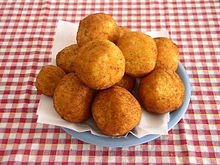

Rice ("riso") dishes are very common in Northern Italy, especially in the Lombardia and Veneto regions, though rice dishes are found throughout the country.
- Arancino
- Insalata di riso
- Pomodori col riso
- Risi e bisi – rice and peas
- Riso alla toscana
- Riso e indivia
- Riso tonnato
- Riso valdostano
- Risotto
- Risotto ai frutti di mare
- Risotto ai funghi
- Risotto con i saltaréi
- Risotto ai quattro sapori
- Risotto al Barolo
- Risotto al cavolfiore
- Risotto al Gorgonzola – risotto prepared with Gorgonzola cheese[24]
- Risotto al nero di seppia
- Risotto al tartufo nero
- Risotto alla marinara
- Risotto alla milanese – risotto with saffron
- Risotto alla pilota
- Risotto alla sbirraglia
- Risotto alla zucca
- Risotto allo zafferano con petto d'anatra
- Risotto con agoni
- Risotto con la lüganega
- Risotto con scamorza e champagne
- Risotto di seppie alla veneziana
- Risotto indivia e fiori di zucca
- Risotto saltato
- Sformato al basilico
- Sformato di riso dolce
- Tiella di riso, patate e cozze
Pesce (fish dishes)



- Acciughe fritte in pastella
- Acciughe in carpione
- Acqua pazza
- Acquadella o latterino fritto
- Agghiotta di pesce spada
- Alici, sardine, anguilla marinate
- Anguilla marinata – marinated eel[25]
- Baccalà
- Baccalà alla lucana
- Baccalà alla vicentina
- Baccalà all'abruzzese
- Baccalà fritto
- Baccalà mantecato[26]
- Boreto alla graisana
- Branzino al sale
- Brodetto di arselle
- Buridda
- Cacciucco
- Calamaretti fritti – fried squid[27][self-published source?]
- Calamari in zimino
- Calamari ripieni
- Capesante alla veneziana
- Cappon magro
- Carpaccio di pesce
- Cartoccio di pesce spada
- Coregone di Campotosto
- Couscous alla trapanese
- Cozza tarantina
- Cozze fritte alla viareggina
- Cozze ripiene
- Filetti di baccalà
- Filetti di orata al cartoccio
- Frittata di bianchetti
- Frittura di pesce (or frittura mista di pesce)
- Grancevola alla veneziana
- Impanata di pesce spada
- Involtini di pesce
- Missultin e polenta
- Moscardini lessati alla genovese
- Murena fritta
- Nasello al forno – baked hake
- Orata arrosto
- Orate al forno
- Pepata di cozze
- Pesce a scabecciu
- Pesce al cartoccio
- Pesce alla pizzaiola
- Pesce spada alla siciliana
- Pesce spada arrosto in salmoriglio
- Polpettine di mare
- Sarde a beccafico – stuffed sardines[28]
- Sarde arraganate (sarde con origano e pane)
- Sarde grigliate
- Sarde in saor
- Sarde ripiene
- Sarde sfiziose panate
- Sardele in saor
- Sbroscia bolsenese
- Scampi a zuppetta
- Scampi gratinati
- Scapece alla vastese
- Seppie col nero alla veneziana
- Seppie con i piselli
- Seppie ripiene
- Seppioline in umido
- Sogliole alla mugnaia
- Spiedini ai frutti di mare
- Spiedini di alici
- Spiedini di anguilla
- Stoccafisso alla genovese
- Stoccafisso alla ligure
- Tonno sott'olio
- Tortiera di cozze
- Totano imbottito
- Triglie alla livornese
- Zuppa di pesce
Carne (meat dishes and cured meats)


- Abbacchio alla cacciatora
- Abbacchio brodettato
- Antipasto di fegatini
- Arrosticini
- Bistecca alla fiorentina ("Florentine beefsteak")
- Braciole
- Braciolone
- Bresaola
- Brodo
- Cacciatore – refers to a meal prepared "hunter-style" with onions, herbs, usually tomatoes, often bell peppers, and sometimes wine.
- Capocollo
- Cappello del prete
- Carne al piatto
- Carne pizzaiola
- Cassoeula
- Ciauscolo
- Coda alla vaccinara
- Coppiette ("couples")
- Cotechino friulano or musèt
- Cotechino
- Cotechino Modena
- Cotoletta
- Cotoletta alla milanese
- Cotoletta alla petroniana
- Culatello
- Farsu magru
- Frittula
- Frìttuli
- Goulash or gulash
- Guanciale ("cured pork jowl")
- Lampredotto
- Likëngë
- Lonza
- Mazzafegato
- Mazzerelle
- Mondeghili
- Mortadella
- Mortadella di Campotosto
- 'Nduja
- Oca ("goose")
- Ossobuco
- Pancetta
- Pani câ meusa
- Pecora alla callara
- Pezzetti di cavallo
- Pollo alla cacciatora
- Porcaloca
- Porchetta
- Porchetta abruzzese
- Prosciutto affumicato ("smoked ham")
- Prosciutto cotto ("cooked ham")
- Prosciutto crudo
- Prosciutto di Parma
- Prosciutto di San Daniele
- Rosticciana
- Salami
- Salame Felino
- Salsiccia ("sausage"), including salsiccia cruda
- Saltimbocca
- Saltimbocca alla romana
- Scaloppine
- Scaloppine alla romana
- Soppressata
- Speck
- Speck Alto Adige PGI
- Speck friulano di Sauris
- Spezzatino
- Straccetti, of various varieties
- Stigghiola
- Supplì
- Torcinello
- Trippa alla romana
- Veal milanese
- Ventricina
- Violino di capra della Valchiavenna
- Vitello ("veal")
- Zampone
Verdure ("vegetables")

- Asparagi bianchi e verdi (asparagus)
- Caponata – a Sicilian aubergine (eggplant) dish consisting of a cooked vegetable salad made from chopped fried eggplant and celery seasoned with sweetened vinegar, with capers in a sweet and sour sauce[29]
- Caprese salad – a salad of tomatoes, mozzarella and basil
- Carciofi alla giudia
- Carciofi alla romana
- Ciambotta
- Crauti (sauerkraut)
- Fiori di zucca
- Giardiniera
- Pantelleria salad (insalata pantesca) – a salad consisting of tomatoes, boiled potatoes, red onions and mackerel (or fresh cheese) and seasoned with olive oil, oregano, salt and capers
- Pantesca salad
- Panzanella – a Tuscan salad of bread and tomatoes, popular in the summer
- Parmigiana
- Peperonata
- Pestât
- Pinzimonio – Italian-style crudités[30]
- Sicilian orange salad (insalata di arance) – a typical salad dish of Sicilian and Spanish cuisine which uses oranges as its main ingredient. It is usually served at the beginning or at the end of a meal.[31]
- Stuffed eggplant (aubergine)
Nut dishes
- Chestnut pie – has been documented back to the 15th century in Italy, in the book De honesta voluptate et valetudine ("On honourable pleasure and health") written by the Italian writer and gastronomist Bartolomeo Platina.[32]
Vini ("wines")



- Abruzzo
- Basilicata
- Aglianico del Vulture
- Grottino di Roccanova
- Matera
- Terre dell'Alta Val d'Agri
- Calabria
- Cirò
- Campania
- Aglianico del Taburno
- Campi Flegrei
- Falerno del Massico
- Fiano di Avellino
- Greco di Tufo
- Lacryma Cristi
- Solopaca
- Taurasi
- Emilia-Romagna
- Friuli-Venezia Giulia
- Friulano
- Pignolo
- Ramandolo
- Refosco dal peduncolo rosso
- Ribolla Gialla
- Schiopettino
- Tazzelenghe
- Verduzzo friulano
- Liguria
- Lombardy
- Oltrepò Pavese
- Barbera
- Bonarda
- Conero
- Franciacorta
- Sassella
- Grumello
- Inferno
- Marche
- Rosso Piceno Superiore
- Spumante Brut
- Valcalepio
- Verdicchio
- Piedmont
- Apulia (Puglia)
- Sardinia
- Sicily
- Cerasuolo di Vittoria
- Donna Fugata
- Etna DOC
- Noto
- Passito di Pantelleria
- Marsala
- Nero d'Avola
- Trentino
- Tuscany
- Bolgheri
- Carmignano
- Chianti
- Colli Apuani
- Colli Etruria Centrale
- Colline Lucchesi
- Elba
- Montalcino
- Montescudaio
- Nipozzano
- Parrina
- Pitigliano
- San Gimignano
- Scansano
- Val di Chiana
- Val di Cornia
- Valdinievole
- Valle di Arbia
- Vino Nobile di Montepulciano
- Umbria
- Grechetto
- Orvieto
- Rosso di Montefalco
- Sagrantino
- Torgiano
- Veneto
- Amarone
- Bardolino
- Colli Euganei
- Conegliano Veneto
- Custoza
- Prosecco
- Soave
- Valdobbiadene
- Valpolicella
Formaggi ("cheeses")

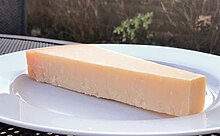

- Asiago
- Asino
- Bel Paese
- Bitto
- Bra
- Burrata
- Burrini
- Butirro
- Caciocavallo
- Cacioricotta
- Canestrato pugliese
- Caprino
- Casècc
- Casiello
- Castelmagno
- Casu martzu
- Ciccillo
- Crescenza
- Crotonese
- Fiore sardo
- Fontina
- Formadi frânt e Formadi salât
- Formai de Mut dell'Alta Valle Brembana
- Giuncata
- Gorgonzola
- Grana Padano
- Latteria
- Liptauer
- Malga
- Marzolino
- Marzotica
- Mascarpone
- Montasio
- Monte Re
- Monte Veronese
- Mozzarella
- Murazzano
- Paddraccio
- Parmigiano-Reggiano (Parmesan)
- Pecorino di Fossa
- Pecorino friulano
- Pecorino romano
- Pecorino sardo
- Piacentinu
- Primo Sale
- Provola silana
- Provolone
- Puzzone di Moena
- Quartirolo Lombardo
- Ragusano
- Raschera
- Ricotta affumicata (Scuete Fumade)
- Ricotta rifatta
- Ricotta salata
- Robiola
- Rosa Camuna
- Salva
- Scamorza
- Silter
- Slattato
- Spongarda
- Squacquerone
- Stracchino
- Tabor
- Taleggio
- Toma
- Tumazzu
- Valtellina Casera
Cheese dishes
Desserts and pastry
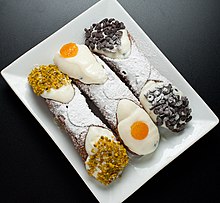

- Aceto dolce – fruit preserves made with vinegar, honey, and grape juice[33]
- Amaretto di Saronno
- Anisette (cookie)
- Babà
- Bisciola
- Biscotto regina
- Biscuit Tortoni
- Buccellato
- Cannolo siciliano
- Cassata siciliana
- Ciarduna
- Cioccolato di Modica
- Crocetta di Caltanissetta
- Crostata
- Crostata di ricotta
- Crostoli
- Cuccìa
- Cuccidati
- Frutta martorana
- Gelato
- Gelo di melone
- Gianduiotto and gianduia – hazelnut chocolates or spread
- Giurgiulena
- Graffe napoletane
- Granita
- Grattachecca
- Gubana
- Maritozzo
- Mostaccino
- 'Mpanatigghi
- Mustacciuoli
- Nocciolini di Canzo
- 'Nzuddi
- Panforte
- Pan meino
- Panpepato
- Panna cotta
- Parrozzo
- Pastiera
- Pignolata
- Pignolo (macaroon)
- Pinza bolognese
- Pizzella
- Profiterole
- Putizza and pinza
- Raffiolini
- Semifreddo
- Sfogliatella
- Spina santa
- Struffoli – tiny fritters held together with honey and decorated with multi-colored sprinkles
- Tiramisu
- Torrone
- Torta Barozzi
- Torta Bertolina
- Torta caprese
- Torta della nonna
- Torta delle rose
- Torta paesana
- U' pastizz 'rtunnar
- Veneziana
- Zabaglione
- Zelten
- Zeppola
- Zuppa inglese
Caffè ("coffee")
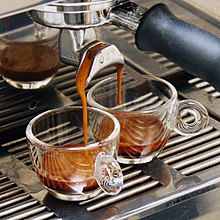
- Bicerin – coffee, hot chocolate and whipped cream, only in Turin
- Caffè americano – believed to have originated in World War II, when American G.I.s in Italy would dilute espresso with hot water to approximate the coffee to which they were accustomed.
- Caffè corretto
- Caffè leccese or caffè in ghiaccio – espresso over ice with addition of almond milk instead of sugar, typical in Salento
- Caffè lungo
- Caffè macchiato
- Caffè moka, made with a moka pot
- Caffè alla napoletana, made with a caffettiera napoletana
- Caffè shakerato, an Italian sweet iced coffee drink
- Latte
- Latte macchiato, similar to a latte, but with less coffee
- Cappuccino
- Espresso – known generally in Italy simply as caffè
- Granita
- Grolla dell'amicizia – coffee and grappa served in a traditional bulbous wooden loving cup, shaped like a multi-spouted teapot, and drunk in the Aosta Valley and Piedmont[citation needed]
- Marocchino – similar to a small cappuccino, invariably served in a glass, and drunk mainly in Turin, in the whole Piedmont and in Milan; similar to the espressino
- Ristretto
- Uovo sbattuto "con caffè". A once popular high energy breakfast, item enjoyed by children.
Other foods
Unique dishes and foods by region
- Asino – cheese of Carnic Prealps
- Brovada or brovade – cooked turnips that were preserved in marc
- Cjarsons – sort of tortellini with a ricotta filling, of the Carnic Alps
- Cuguluf – leavened cake of Viennese origin
- Formadi frânt and Formadi salât – cheeses
- Frico – sliced cooked potatoes with onions and Montasio cheese
- Gubana – cake made with a very rich filling of dry fruits, raisins and candied citron
- Kipfel – small fried crescent, made with a kind of potato dumpling dough
- Montasio – cheese of the Friuli
- Prosciutto di San Daniele DOP, famous ham exported all over the world
- Scuete fumade – sweet smoked ricotta
- Smoked hams of Sauris, of Cormons and of the Carso plateau
- Speck friulano of Sauris
- Bigoli con l'arna – a type of pasta similar to tagliatelle but bigger with a sauce of liver of the duck
- Galani or crostoli – pastries
- Lesso e pearà – boiled meats with pepper sauce, most common in the province of Verona
- Pasta e fagioli – a soup of pasta and beans
- Polenta e osei – polenta accompanied with roasted wild birds
- Radicchio e pancetta – raw or cooked radicchio salad with pancetta
- Risi e bisi – rice with young peas
- Sarde in saor – fried, marinated sardines
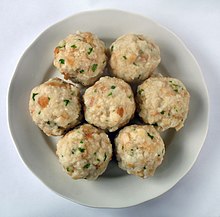
- Carne salada e fasoi – aromatized salt beef with beans
- Crauti – sauerkraut
- Minestrone di orzetto – barley soup
- Speck – a type of salume from the historical-geographical region of Tyrol and generally obtained from pork leg subjected to a process of cold-smoking
- Strangolapreti – spinach dumplings
- Spätzle – a typical Trentino Alto Adige first course, similar to strozzapreti in flavour, different in form
- Zelten – a typical dessert of the Christmas tradition of the Trentino-Alto Adige region. Made with dried fruit (pine nuts, walnuts, almonds) and candied fruit.
- Grostoli (in dialect Grostoi (Grøśtœį)) – typical fried dessert from the Trentino-Alto Adige culture
- Strauben – Austro-Hungarian culinary artefact, served in every alpine hut with plenty of "currant jam" (marmelada de ribes) on top




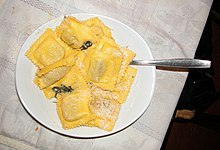







- Agnolini – a type of egg-based stuffed pasta originating from the province of Mantua (in the Mantuan dialect they are commonly called agnulìn or agnulì), often eaten in soup or broth
- Amaretti di Saronno – a type of amaretto, a bitter-sweet flavored macaron, that is traditional to Saronno, a comune of Lombardy
- Bel Paese – a semi-soft cheese. It was invented in 1906 by Egidio Galbani who wanted to produce a mild and delicate cheese to sell mainly in Italy. The name Bel Paese comes from the title of a book written by Antonio Stoppani (though the reference is much older, being used by Dante and Petrarch). It is Italian for "beautiful country", and is used as a phrase for Italy itself.[34]
- Bisciola – an artisanal sweet leavened bread originating from the Valtellina valley of Lombardy, Italy.[35] It is typically prepared for Christmas[35] during which time it is an essential component of Christmas festivities.[36]
- Bitto – a DOP (denominazione di origine protetta) cheese produced in the Valtelline Valley, in Lombardy. It owes its name to the Bitto River. Bitto is produced only in the summer months, when the cows feed on the high alpine meadows.
- Bresaola – an air-dried, salted beef (but it can also be made of horse, venison and pork) that has been aged two or three months until it becomes hard and turns a dark red, almost purple color. It is made from top (inside) round, and it is lean and tender, with a sweet, musty smell.[37]
- Casoncelli – a kind of stuffed pasta, typical of the culinary tradition of Lombardy, in the north-central part of Italy[38]
- Cassoeula – a typical winter dish popular in Western Lombardy. The dish has a strong, decisive flavour, and was a favourite of conductor Arturo Toscanini.[39] One writer describes it as a "noble, ancient Milanese dish",[40] and writes of the inexpressible "pleasure that it furnishes the soul as well as the palate, especially on a wintry day".[40]
- Colomba di Pasqua – a traditional Easter bread, the counterpart of the two well-known Italian Christmas desserts, panettone and pandoro
- Gorgonzola – a veined PDO Italian blue cheese, made from unskimmed cow's milk. It can be buttery or firm, crumbly and quite salty, with a "bite" from its blue veining.[41] Outside the EU and the countries recognizing the geographical origin protection, the name "Gorgonzola" can legally be used for similar cheeses, with only the full Italian name unambiguously referring to PDO Gorgonzola. It is a famously pungent cheese.
- Mascarpone – a soft acid-set cream cheese.[42][43][44] It is recognized in Italy as a prodotto agroalimentare tradizionale ("traditional agri-food product"; PAT).[45]
- Michetta – a white bread, recognizable by its bulged shape
- Mondeghili – meatballs typical of Milanese cuisine in the Italian region of Lombardy. The main ingredient of the dish is leftover meat, usually beef because of its popularity in Milan: the dish was developed to use up leftover cuts of beef. The meatballs are also enriched with sausage, raw salami, liver, mortadella and other pork.[46] The first attested recipe for mondeghili dates back to 1839.[46]
- Mostaccino – a spicy cookie typical of Crema, Lombardy, Italy. Mainly used in the preparation of the filling of tortelli cremaschi, it includes nutmeg, cinnamon, cloves, mace, cilantro, star anise, black pepper and cocoa among the ingredients.[47] It has a spicy flavour.[48]
- Mostarda di Cremona – a sweet/spicy sauce made with candied fruits and meant to be served along boiled beef
- Nocciolini di Canzo – a small sweet amaretto-style biscuits with hazelnut flour
- Ossobuco – a specialty of Lombard cuisine of cross-cut veal shanks braised with vegetables, white wine, and broth. It is often garnished with gremolata and traditionally served with either risotto alla milanese or polenta, depending on the regional variation.[49] The marrow in the hole in the bone, a prized delicacy, is the defining feature of the dish.[50][51]
- Pan meino – a typical Lombard dessert, from the provinces of Milan, Monza, Lodi, Lecco and Como. Pan Meino is a small sweet flatbread flavored with elderflower.
- Panettone – a Milanese Christmas traditional sweet bread made with a yeast and egg dough along with candied citrus peel, and raisins
- Pizzoccheri – buckwheat tagliatelle dressed with potatoes, greens (often Swiss chard or spinach), butter and Bitto cheese: a speciality of the Valtellina
- Quartirolo Lombardo – a soft cheese made with cow's milk, which has a Protected designation of origin (PDO) status
- Risotto alla milanese – a stirred rice dish made with Vialone or Carnaroli rice flavored with saffron and beef marrow
- Rosa Camuna – a mild semi-hard paste cheese made with partially skimmed cow's milk. Its shape and name come from the Camunian rose of Val Camonica where the cheese is produced.
- Salame di Varzi
- Salva – a cheese from Crema (PDO) made with raw curd. It is a washed-rind cheese that undergoes a medium or long aging period.
- Silter – a hard cheese made within the Alpine Lombardy region around province of Brescia and surrounding areas and traditionally produced with unpasteurised cows milk during summer months and September.[52][53] It is brined.[54]
- Spongarda – a local cake with its origins in Crema. The Lombardy region includes it as "Spongarda of Crema" in the list of traditional food products.[55]
- Taleggio – a semisoft, washed-rind, smear-ripened Italian cheese that is named after Val Taleggio. The cheese has a thin crust and a strong aroma, but its flavour is comparatively mild with an unusual fruity tang. Taleggio and similar cheeses have been around since Roman times, with Cicero, Cato the Elder, and Pliny the Elder all mentioning it in their writings.
- Torrone – a candy made of honey, sugar, and egg white, with toasted almonds or hazelnuts
- Torta Bertolina – a typical autumnal dessert from the northern Italian town of Crema. It is presented in a round shape, but it is often available cut into slices. It has a golden brown hue and the fragrance of the small American or Concord grapes which are one of its main ingredients. The crust has an uneven texture with small holes in it.
- Torta delle rose – a typical cake of Mantuan and Brescian cuisine. It is made with leavened dough rich in butter and sugar, which is rolled up and placed in the baking tin, taking the characteristic shape of a basket of rosebuds, hence the name.[56]
- Torta paesana – a cake of the Lombard cuisine, notably from Brianza.[57] Its main ingredients are stale bread, milk and cocoa, often enriched with biscuits, amaretti di Saronno, sugar, pine seeds, raisins, candied orange and citron and aromatized with anise.[58]
- Tortelli di zucca – ravioli with a squash filling
- Valtellina Casera – a cheese made from semi-skimmed cows' milk in the northern Italian province of Sondrio.[59] Its origins date back to the sixteenth century and it is much used in the cuisine of the Valtellina: particularly in dishes based on buckwheat flour such as pizzoccheri and sciatt (toad(s) in Lombard language).[59][60]
- Veal milanese – a popular variety of cotoletta[61] found in the city of Milan. It is traditionally prepared with a veal rib chop or sirloin bone-in and made into a breaded cutlet, fried in butter.
- Veneziana – a sweet of the Lombard cuisine covered with sugar grains or almond icing.[62] It is served in two versions: the bigger one is consumed during Christmas,[63] like panettone; the smaller one is eaten as breakfast, along with cappuccino, like croissants. Veneziana is butter and flour-based and uses sourdough as leavening;[64] the smaller version is usually plain, sometimes filled with custard, while the bigger version contains candied orange.
- Zuppa alla pavese – a soup consisting of broth into which slices of stale bread and poached eggs are placed. It is generally served with grated Parmesan.[65] Usually in Lombardy either Grana Padano or Granone Lodigiano are used.
- Tortino di riso alla valdostana – rice cake with ox tongue
- Zuppa alla valpellinese – savoy cabbage stew thickened with stale bread
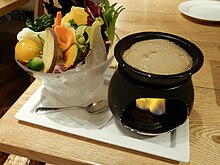

- Bagna càuda – a hot dip based on anchovies, olive oil and garlic (sometimes blanched in milk), to accompany vegetables (either raw or cooked), meat or fried polenta sticks
- Bollito misto
- Brasato al vino – stew made from wine marinated beef
- Gnocchi di semolino alla romana – semolina dumpling
- Lepre in civet – jugged hare
- Paniscia di Novara – a dish based on rice with borlotti beans, salame sotto grasso and red wine
- Panissa di Vercelli – a dish based on rice with borlotti beans, salame sotto grasso and red wine
- Panna cotta – sweetened cream set with gelatin
- Pere San Martin al vino rosso – winter pears in red wine
- Risotto alla piemontese – risotto cooked with meat broth and seasoned with nutmeg, Parmesan and truffle
- Vitello tonnato – veal in tuna sauce
- Rane fritte – fried frogs
- Riso e rane – risotto with frogs
- Salame sotto grasso – pork salami aged under a thick layer of lard

- Agliata – the direct ancestor of pesto, it is a spread made from garlic cloves, egg yolk and olive oil pestled in a mortar until creamy.
- Baccalà fritto – morsels of salt cod dipped in flour batter and fried
- Bagnun – a soup made with fresh anchovies, onion, olive oil and tomato sauce where crusty bread is then dipped; originally prepared by fishermen on long fishing expeditions and eaten with hard tack instead of bread.
- Bianchetti – whitebait of anchovies and sardines, usually boiled and eaten with lemon juice, salt and olive oil as an entrée
- Buridda – seafood stew
- Cappon magro – a preparation of fish, shellfishes and vegetables layered in an aspic
- Capra e fagioli – a stew made of goat meat and white beans, a typical dish of the hinterland of Imperia
- Cima alla genovese – this cold preparation features an outer layer of beef breast made into a pocket and stuffed with a mix of brain, lard, onion, carrot, peas, eggs and breadcrumbs, then sewn and boiled. It is then sliced and eaten as an entrée or a sandwich filler.
- Cobeletti – sweet corn tarts
- Condigiun – a salad made with tomatoes, bell peppers, cucumber, black olives, basil, garlic, anchovies, hard boiled egg, oregano and tuna
- Farinata di zucca – a preparation similar to chickpea farinata substituting pumpkin for the legumes' flour as its main ingredient; the result is slightly sweeter and thicker than the original.
- Galantina – similar to testa in cassetta, but with added veal
- Latte dolce fritto – a thick milk based cream left to solidify, then cut in rectangular pieces which are breaded and fried
- Maccheroni con la trippa – a traditional Savonese soup uniting macaroni pasta, tripe, onion, carrot, sausage, "cardo", which is the Italian word for Swiss chard, parsley, and white wine in a base of capon broth, with olive oil to help make it satisyfing. Tomato may be added but that is not the traditional way to make it (traditional ingredients: chicken or capon broth, carrot, onion, parsley, thistle leaves, veal tripe, pork sausage, maccheroni al torchio, white wine, butter, olive oil, Parmesan cheese, salt).
- Mescciüa – a soup of chickpeas, beans and wheat grains, typical of eastern Liguria and likely of Arab origin
- Mosciamme – originally a cut of dolphin meat dried and then made tender again thanks to immersion in olive oil, for several decades tuna has replaced dolphin meat
- Pandolce – sweet bread made with raisins, pine nuts and candied orange and cedar skins
- Panera genovese – a kind of semifreddo rich in cream and eggs flavoured with coffee, similar to a cappuccino in ice cream form
- Panissa and farinata – chickpea-based polentas and pancakes respectively
- Pesto – probably Liguria's most famous recipe, widely enjoyed beyond regional borders, is a green sauce made from basil leaves, sliced garlic, pine nuts, pecorino or Parmesan (or a mix of both) and olive oil. Traditionally used as a pasta dressing (especially with gnocchi or trenette, it is finding wider uses as sandwich spread and finger-food filler).
- Pizza all'Andrea – focaccia-style pizza topped with tomato slices (not sauce) onions and anchovies
- Scabeggio – fried fish marinated in wine, garlic, lemon juice and sage, typical of Moneglia
- Sgabei – fritters made from bread dough (often incorporating some cornmeal in it)
- Stecchi alla genovese – wooden skewers alternating morsels of leftover chicken meats (crests, testicles, livers...) and mushrooms, dipped in white béchamel sauce, left to dry a bit and then breaded and fried
- Testa in cassetta – a salami made from all kind of leftover meats from pork butchering (especially from the head)
- Torta di riso – unlike all other rice cakes this preparation is not sweet, but a savoury pie made with rice, caillé, Parmesan and eggs, it can be wrapped in a thin layer of dough or simply baked until firm.
- Torta pasqualina – savory flan filled with a mixture of green vegetables, ricotta and Parmesan cheese, milk and marjoram; some eggs are then poured in the already-placed filling, so that their yolks will remain whole when cooked.
- Trenette col pesto – pasta with pesto (olive oil, garlic, basil, Parmesan and pecorino sardo cheese) sauce




- Traditional balsamic vinegar and balsamic vinegar – very precious, expensive and rare sweet, dark, sweet and aromatic vinegar, made in small quantities according to elaborated and time-consuming procedures (it takes at least 12 years to brew the youngest aceto balsamico) from local grapes must (look for the essential tradizionale denomination on the label to avoid confusing it with the cheaper and completely different aceto balsamico di Modena vinegar, mass-produced from wine and other ingredients
- Borlengo, from the hills South of Modena
- Cannelloni, crespelle and rosette – pasta filled with béchamel, cream, ham and others
- Cappellacci – large size filled egg pasta with chestnut puree and sweet mostarda di Bologna, from Romagna
- Cappelletti – small egg pasta "hats" filled with ricotta, parsley, Parmesan and nutmeg, sometimes also chicken breast or pork and lemon zest, from Emilia, in particular Reggio
- Cappello del prete – tricorno hat shaped bag of pork rind with stuffing similar to zampone's, to be boiled (from Parma, Reggio Emilia and Modena)
- Ciccioli – cold meat made with pig's feet and head from Modena
- Coppa – cured pork neck form Piacenza and Parma
- Cotechino – big raw spiced pork sausage to be boiled, stuffing rich in pork rind (from Emilia provinces)
- Baked crescentine or tigelle (currently known also as "tigelle", that is the traditional name of the stone dies which crescentine were baked between) – a small round (approx. 8 cm diameter, 1 cm or less thick) flat bread from the Modena Apennine Mountains
- Crescentine – flat bread from Bologna and Modena: to be fried in pork fat or baked between hot dies (see tigelle above)
- Culatello – a cured ham made with the most tender of the pork rump: the best is from the small Zibello (culatello di Zibello) area, in Parma lowlands.
- Erbazzone – spinach and cheese filled pie from Reggio Emilia
- Fave stufate – broad beans with mortadella
- Garganelli – typical Romagna quill shaped egg pasta usually dressed with guanciale ("cheek bacon"), peas, Parmesan and a hint of cream
- Gnocco fritto – fried pastry puffs from Modena (gnocco fritto was a very local name: until few decades ago it was unknown even in neighbouring Emilian provinces where different denominations, i.e. crescentine fritte in Bologna, for similar fried puffs).
- Gramigna con salsiccia – typical Bologna short and small diameter curly pasta pipes with sausage ragù
- Mortadella – baked sweet and aromatic pork sausage from Bologna
- Panpepato – very rich Christmas dried fruit and nut dessert with almonds, candies and a lot of sweet spices
- Parmesan – prized ancient long-aged cheese from Reggio Emilia, Parma, Modena and Bologna
- Passatelli – noodles made of breadcrumbs, Parmesan cheese, lemon zest and nutmeg from Romagna pesto di Modena – cured pork back fat pounded with garlic, rosemary and Parmesan used to fill borlenghi and baked crescentine
- Piadina fritta – fried Romagna pastry rectangles
- Piadina – pancake shaped flat bread (from Romagna) which can be smaller and higher or larger and very thin
- Pinza bolognese – jam-filled pastry
- Pisarei e faśö – pasta peas with beans from Piacenza
- Salame Felino – salami from province of Parma
- Salamina da sugo – soft sausage from Ferrara, seasonal
- Spalla di San Secondo – gourmet salami from a small town near Parma; it is made with seasoned pork shoulder, stuffed in cow bladders and slowly boiled or steamed.
- Spongata – very rich Christmas time thin tart: a soft crust with flour sugar dusting, stuffed with finely broken almonds and other nuts, candies and a lot of sweet spices, from Reggio Emilia
- Squacquerone – sweet, runny, milky cheese from Romagna
- Tagliatelle – egg pasta noodles, very popular across Emilia-Romagna; they are made in slightly different thickness, width and length according to local practise (in Bologna the authentic size of tagliatelle alla bolognese is officially registered at the local Chamber of Commerce).
- Torresani – roasted pigeons popular in Emilia
- Torta Barozzi o torta nera ("Barozzi tart" or "black tart") – a dessert made with a coffee/cocoa and almond filling encased in a fine pastry dough (from Modena)
- Tortelli alla lastra – griddle baked pasta rectangles filed with potato and pumpkin puree and sausage or bacon bits
- Tortelli – usually square, made in all Emilia-Romagna, filled with Swiss chard or spinach, ricotta and Parmesan in Romagna or ricotta, parsley, Parmesan in Bologna (where they are called "tortelloni") and Emilia, or with potatoes and pancetta in the Apennine mountains
- Tortellini – small egg pasta navel shapes filled with lean pork, eggs, Parmesan, mortadella, prosciutto di Parma and nutmeg (from Bologna and Modena: according to a legend, they were invented in Castelfranco Emilia by a peeping innkeeper after the navel of a beautiful guest)
- Zampone – stuffed pig's trotter, fat, but leaner than cotechino's, stuffing; to be boiled (from Modena)

- Bistecca alla fiorentina – grilled Florentine T-bone steak traditionally from the Chianina cattle breed
- Crema paradiso – Tuscan cream
- Fegatelli di maiale – pig's liver forcemeat stuffed into pig's stomach and baked in a slow oven with stock and red wine
- Ossibuchi alla toscana – ossobuco "Tuscan-style"
- Pinzimonio – fresh seasonal raw or slightly blanched vegetables served with seasoned olive oil for dipping
- Ribollita – twice-cooked vegetable soup
- Lampredotto – cooked abomasum
Tuscan bread specialties
- Carsenta lunigianese – baked on a bed of chestnut leaves and served on Good Friday
- Ciaccia – from the Maremma made from maize
- Donzelle – round loaf fried in olive oil
- Fiandolone – made with sweet chestnut flour and strewn with rosemary leaves
- Filone – classic Tuscan unsalted bread
- Pan di granturco – made from maize flour
- Pan di ramerino – a rosemary bread seasoned with sugar and salt. The bread was originally served during Holy Week decorated with a cross on top and sold at the Church by semellai; it is, however, offered year round now.
- Pan maoko – equal parts wheat and maize flour, with pine nuts and raisins added
- Pane classico integrale – unsalted bread made with semolina with a crisp crust
- Pane con i grassetti – a bread from the Garfagnana area, with pork cracklings mixed in
- Pane con l'uva – in other areas this bread often takes the form of small loaves or rolls, but in Tuscany it is a rolled-out dough with red grapes incorporated into it and sprinkled with sugar. It is bread served often in the autumn in place of dessert and often served with figs.
- Panigaccio – Lunigiana specialty made with flour, water and salt baked over red-hot coals and served with cheese and olive oil
- Panina gialla aretina – an Easter bread with a high fat content, containing raisins, saffron, and spices. It is consecrated in a church before being served with eggs.
- Panini di Sant'Antonio – sweet rolls eaten on the feast day of St. Anthony
- Schiacciata – dough rolled out onto baking sheet and can have pork cracklings, herbs, potatoes and/or tomatoes added to the top along with a salt and olive oil
- Schiacciatina – made with a fine flour, salt dough with yeast and olive oil
- Panino co' i' lampredotto – lampredotto sandwich
- Lenticchie di Castelluccio con salsicce – lentil stew with sausages
- Minestra di farro – spelt soup
- Piccioni allo spiedo – spit-roasted pigeon
- Regina in porchetta – carp in fennel sauce
Specialties of the Norcineria (Umbrian Butcher)
- Barbozzo – cured, matured pig's cheek
- Budellacci – smoked, spiced pig intestines eaten raw, spit-roasted, or broiled
- Capocollo – Sausage highly seasoned with garlic and pepper
- Coppa – sausage made from the pig's head
- Mazzafegati – sweet or hot pig's liver sausage, the sweet version containing raisins, orange peel and sugar
- Prosciutto di Norcia – a pressed, cured ham made from the legs of pigs fed on a strict diet of acorns[66]
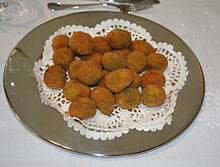
- Brodetto di San Benedetto del Tronto – fish stew, San Benedetto del Tronto-style, with green tomatoes and sweet green pepper[67]
- Brodetto di Porto Recanati – fish stew, without tomato, wild saffron spiced
- Olive all'ascolana – fried stoned olives stuffed with pork, beef, chicken, eggs and Parmesan in Ascoli Piceno[68]
- Passatelli all'urbinate – spinach and meat dumplings
Unique ham and sausage specialties
- Coppa – coppa in this region refers to a boiling sausage made from pig's head, bacon, orange peel, nutmeg and sometimes pinenuts or almonds. It is meant to be eaten within a month of preparation.
- Ciauscolo – made from the belly and shoulder of pig with half its weight in pork fat and seasoned with salt, pepper, orange peel and fennel. It is stuffed into an intestine casing, dried in a smoking chamber and cured for three weeks.
- Fegatino – a liver sausage with pork belly and shoulder, where the liver replaces the fat of other sausages
- Mazzafegato di Fabriano – mortadella made from fat and lean pork with liver and lung added to the fine-grained emulsification. It is seasoned with salt and pepper, stuffed into casings and smoked. This sausage is often served at festivals.
- Prosciutto del Montefeltro – made from free-range black pigs, this is a smoked prosciutto washed with vinegar and ground black pepper
- Salame del Montefeltro – made from the leg and loin meat of the black pig, this sausage is highly seasoned with peppercorns and hung to dry
- Salame di Fabriano – similar to salame lardellato, except that it is made solely from leg of pork with pepper and salt
- Salame lardellato – made with lean pork shoulder, or leg meat, along with diced bacon, salt, pepper, and whole peppercorns. It is cased in hog's intestines, dried for one-and-a-half days and then placed in a warm room for 3–4 days, two days in a cold room and then two months in a ventilated storage room.
- Soppressata di Fabriano – finely emulsified pork flavored with bacon, salt and pepper. The sausage is smoked and then aged.

- Bucatini all'amatriciana – bucatini with guanciale, tomatoes and pecorino
- Carciofi alla giudia – artichokes fried in olive oil, typical of Roman Jewish cooking
- Carciofi alla romana – artichokes Roman-style; outer leaves removed, stuffed with mint, garlic, breadcrumbs and braised
- Coda di bue alla vaccinara – oxtail ragout
- Pasta alla gricia
- Saltimbocca alla romana – veal cutlet, Roman-style; topped with raw ham and sage and simmered with white wine and butter
- Spaghetti alla carbonara – spaghetti with eggs, guanciale and pecorino
- Agnello casc' e ove – lamb stuffed with grated pecorino and eggs
- Agnello con le olive
- Arrosticini – skewered pieces of meat
- Maccheroni alla chitarra – a narrow stripped pasta served with a sauce of tomatoes, bacon and pecorino
- Maccheroni alla molinara (also known as la pasta alla mugnaia) – a long (single) hand made pasta served with tomato sauce
- Mozzarelline allo zafferano – mini mozzarella cheese coated with a batter flavored with saffron
- Parrozzo – a cake-like dessert made from a mixture of flour and crushed almonds, and coated in chocolate
- Pizza dolce – a layered (with two or three cream fillings – white custard, chocolate or almond) sponge cake, that is soaked with alchermes (if you can find it) or rum.
- Pizzelle (also known as ferratelle) – a thin, cookie made with a waffle iron device, often flavored with anise
- Spaghetti all'aglio, olio e peperoncino
- Scripelle 'mbusse – Abruzzo crêpes (flour, water and eggs), seasoned with pecorino, rolled and served in chicken broth
- Sugo di castrato – mutton sauce made with onion, rosemary, bacon, white wine, and tomatoes
- Timballo teremana – a lasagne made with scripelle (Abruzzo crêpes) layered with a ragout of beef, pork, onion, carrot and celery, also layered with mushrooms, crumbled hard boiled egg, peas and béchamel sauce
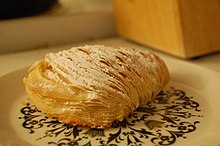

- Braciole di maiale – pork loin with tomatoes sauce, garlic, capers and pine nuts
- Caponata di pesce – fish caponata; bread (baked in the shape of a donut), anchovies, tuna, lemon juice, olive oil and pepper
- Casatiello – Neapolitan Easter pie with Parmesan, pecorino, eggs, salami, bacon, and pepper
- Gattò – a Neapolitan potato casserole with ham, Parmesan and pecorino
- Graffe – fried Neapolitan "doughnuts" made with flour, potato, yeast and sugar
- Caprese salad – salad of tomatoes, mozzarella and basil
- Limoncello – lemon liqueur
- Maccheroni alla napoletana – macaroni with Neapolitan sauce; a sauce of braised beef, carrot, celery, onion, garlic, white wine, tomato paste and fresh basil
- Melanzane alla scapece – scapece eggplant; marinated eggplant with red pepper and olive oil
- Melanzane al cioccolato – mid-August dessert; eggplants with chocolate and almonds
- Mozzarella di bufala campana – particular variety of cheese products made exclusively with milk from buffalo
- Mozzarella in carrozza – fried mozzarella with slices of toasted bread and olive oil
- Mustacciuoli – Neapolitan Christmas dessert; cookies with almonds and coffee covered with chocolate
- Parmigiana – sliced eggplant pan fried in oil, layered with tomato sauce and cheese, and baked in an oven
- Pastiera napoletana – Neapolitan ricotta cake
- Pepata di cozze – mussel and Clam soup with tomato sauce, served with slices of toasted bread
- Pizza napoletana ("Neapolitan pizza") – the most popular is "pizza Margherita": pizza topped with tomatoes sauce, mozzarella, Parmesan, basil and olive oil
- Polipo alla Luciana ("Luciana octopus") – octopus with tomatoes sauce, chopped tomatoes, olives and garlic
- Ragù napoletano ("Neapolitan ragù") – tomatoes sauce, onions, olive oil, carrots, celery, veal shank, pork ribs, lard, basil, salt and pepper
- Roccocò – Neapolitan Christmas dessert; almond crunch cookies
- Sartù di riso ("rice sartù") – rice with mushrooms, onions, tomato-paste, beef, peas, Parmesan, mozzarella and olive oil
- Sfogliatelle – Neapolitan ricotta dessert; seashell-shaped pastry with ricotta
- Sfogliatella Santa Rosa – Neapolitan dessert; slightly larger than a traditional sfogliatella, it is filled with a crema pasticciera and garnished with crema di amarene ("sour black cherry").
- Spaghetti alle vongole – spaghetti with clams in a white sauce with garlic, olive oil and pepper
- Struffoli – Neapolitan Christmas dessert; honey balls with lemon juice and colored candy
- Torta caprese – chocolate cake with almonds
- Zeppole di San Giuseppe – fritters for Saint Joseph's Day; cream-filled with crème pâtissière

- Burrata – an Italian cow milk cheese (occasionally buffalo milk) made from mozzarella and cream. The outer casing is solid cheese, while the inside contains stracciatella and cream, giving it an unusual, soft texture. It is typical of Apulia.
- Caciocavallo podolico – a variety of cheese products made exclusively with Podolica cow milk
- Cacioricotta – a cheese produced throughout Apulia
- Calzone (in Lecce) or panzerotto (in Bari and Taranto) – puff pastry with oil which in its typicality contemplated the use of olives, ham, onions, mozzarella, cheese and tomato sauce for filling. Cooked either in the oven as savory pie, or deep fried.
- Cartellate – a pastry, particularly prepared around Christmas, made of a thin strip of a dough made of flour, olive oil, and white wine that is wrapped upon itself, intentionally leaving cavities and openings, to form a sort of "rose" shape; the dough is then deep-fried, dried, and soaked in either lukewarm vincotto or honey.
- Muscisca – bacon or boneless meat from sheep or goat (and in some cases veal), which is cut into long (20–30 cm) and thin (3–4 cm) strips, and seasoned with salt, chili, and fennel seeds before being sun-dried
- Orecchiette con le cime di rapa – ear-like pasta with rapini
- Ostriche arrosto – oysters broiled with parsley, garlic, oregano, breadcrumbs, olive oil, and lemon juice
- Pancotto – an ancient dish of Capitanata, made from a base of stale bread and accompanied with a wide variety of wild vegetables, fennel seeds, oil of Tavoliere, and chili peppers
- Pasticciotto leccese – shortcrust pastry shell and a custard heart
- Pitta di patate – potato focaccia stuffed with tomatoes, onions, bacon, mozzarella, parsley, and covered with breadcrumbs
- Purea di fave (or fave e cicorie, also known as fave e fogghije, "fava beans and leaves") – fava bean puree with stewed cicory. During Christmas festivities, cicory is stewed in red wine instead of water.
- Riso, patate e cozze or tiella barese – a Bari specialty made with rice, potatoes, and mussels, similar to paella, cooked in an earthenware pan or in the oven. It has a Salento variant called tajeddha. It is likely that this recipe is a variant of paella, given the long Spanish domination in the Kingdom of Naples.
- Rustico leccese – typical street food of Salento: a puff pastry filled with béchamel, mozzarella and tomato
- Sagne 'ncannulate or sagne torte – home made pasta typical of Salento in the shape of long lagane rolled up on themselves that are served with fresh tomato sauce, basil and cacioricotta (someone adds a little breadcrumbs to dry any residual draining water), others use ricotta 'scante (a spicy ricotta cream), or with meat sauce (pork or lamb) with the addition of chilli, to taste.
- Tiella di verdure – a casserole of baked vegetables topped with mozzarella and fresh basil.
- Torcinelli – lamb intestines wrapped around lamb liver or offal, typically testicles, generally grilled on a skewer, sometimes stewed in tomato and onions
- Zuppa di cozze alla tarantina – mussels steamed with peperoncino, garlic, tomatoes, and white wine. Often eaten with short pasta types. Variations prepared in the hinterland of Taranto may include white beans or kidney beans.
Apulian bread specialties
- Focaccia ripiena – a bread made of dough filled with mozzarella, tomatoes, ham, onion or leek, and served in slices
- Friselle – a bread made from barley flour and durum wheat flour, which goes through a dual baking process becoming very similar to hardtack, and is soaked in water before being prepared and eaten
- Pane casareccio – a bread made from durum wheat, yeast, flour, salt, and water
- Pane di Altamura – sourdough durum wheat bread weighing up to 44 lb (20 kg)
- Puccia con le olive – a bread filled with olives
- Puccia di pane – a bread made in honor of the Virgin Mary. It is a small, soft, round loaf made of white flour.
- Puddica – bread dough mixed with mashed potato and rolled into flat cakes, covered with halved tomatoes and seasoned with salt and pepper
- Taralli – a ring-shaped snack food which can be sweet or savory

- Agnello alla pastora – lamb with potatoes
- Baccalà alla lucana – cod with crunchy red peppers
- Ciaudedda – stew with artichokes, potatoes, broad beans and pancetta
- Orecchiette con la salsiccia piccante – ear-like pasta with typical spicy salami from Basilicata
- Pecorino di Forenza – cheese made of sheep's milk, typical of the Forenza area
- Pasta con i peperoni cruschi – pasta dish served with peperoni cruschi ("crispy peppers"), fried bread crumb and cacioricotta
- Pasta mollicata – pasta dish served with tomato, onion dipped in red wine, lard and cacioricotta
- Pollo alla potentina – Potenza-style chicken; chicken braised with tomatoes, onion, white wine, peperoncino, topped with fresh basil, parsley and pecorino cheese
- Rafanata – type of omelette with horseradish, potatoes and cheese
- Tumact me tulez – pasta dish served with tomato, anchovy, fried bread crumb and chopped walnuts
- U' pastizz 'rtunnar – baked turnover filled with pork, eggs and cheese
- Caciocavallo – a very milky cheese
- Cuzzupa
- Insalata di pomodoro – a tomato salad with hot pepper
- Maccarruni i'casa – home made pasta with goat or pork meat and tomatoes
- Melanzane alla menta – eggplant marinated with mint
- Melanzane ripiene – stuffed eggplant
- 'Nduja – a spicy preserved meat, similar to the French Andouille
- Pesce spada alla ghiotta – swordfish rolls in tomato sauce
- Pipi chini – padded pepper
- Pisci stoccu – stockfish with olive, tomatoes and caper bush
- Satizzu – typical sausages made with fennel and pepper (the prototypical "Italian" sausage as sold in the United States)
- Soppressata – a uniquely Calabrian salami
- Zippuli
- Arancini – stuffed rice balls which are coated with breadcrumbs and fried
- Cannoli – shortcrust pastry cylinder shell filled with sweet ricotta, mascarpone or chocolate or vanilla cream
- Caponata – eggplants with tomatoes and olives
- Couscous alla trapanese
- Il timballo del gattopardo – Sicilian pie; pastry dough baked with a filling of penne rigate, Parmesan, and bound a sauce of ham, chicken, liver, onion, carrot, truffles, diced hard-boiled egg and seasoned with clove, cinnamon, salt and pepper. Gattopardo ("serval") makes reference to the arms of the Lampedusa family and Giuseppe Tomasi di Lampedusa's well-known novel Il Gattopardo, not the contents of the dish.
- Granita – semi-frozen dessert made from sugar, water and various flavorings, typically lemon or almond or coffee or mulberry
- Maccu di San Giuseppe – bean paste with fennel
- Pantesca salad – dish of the island of Pantelleria
- Pasta alla Norma – spaghetti with tomato and eggplant
- Panelle – a Sicilian chickpea fritter, often eaten as a sandwich and popular as street food
- Scaccia – flat bread stuffed in different ways
- Pizza siciliana (lit. 'Sicilian pizza') – pizza prepared in a manner that originated in Sicily
- Tonno alla palermitana – tuna Palermo-style; tuna marinated in white wine, lemon, garlic, rosemary and broiled, then served with pan-seared sardines
- Casu martzu – type of cheese
- Culurgiones – a kind of ravioli
- Malloreddus – semolina gnocchi with saffron
- Pane carasau – type of bread
- Porcetto or porceddu – small pig cooked with myrtle
- Panada – a pie filled with meat or vegetables
- Zuppa cuata – bread and cheese soup
Ingredients
Most important ingredients (see also: Italian Herbs and Spices):
- Extra-virgin olive oil
- Parmesan (aged cow's-milk cheese)
- Pecorino (aged sheep's-milk cheese)
- Tomato
-
Italian vine tomatoes
Other common ingredients
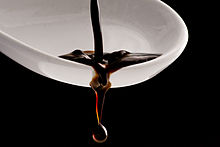


- Anchovies, preserved in olive oil, or in salt
- Asparagus
- Balsamic vinegar
- Baccala (dried, salted cod)
- Bresaola (air-dried salted beef)
- Broccoli
- Butter
- Capers, preserved in vinegar or, more frequently, salt
- Artichokes
- Cauliflower
- Kale
- Chickpeas
- Cucumber
- Chicory
- Sauerkraut
- Beans
- Farro ("emmer")
- strawberries
- Rape
- Porcini mushrooms, white mushrooms
- Lard
- Lentils
- Lemon
- Eggplants (aubergines)
- Apples
- Honey
- Hazelnuts
- Walnuts
- Olives
- Barley
- Pasta
- Potatoes
- Swordfish
- Bell peppers
- Pears
- Pestât
- Pesto
- Pine nuts
- Peas
- Pistachios
- Polenta
- Prosciutto
- Radicchio – leaf chicory (Cichorium intybus, Asteraceae), sometimes known as Italian chicory. Radicchio rosso di Treviso resembles a large red Belgian endive.
- Ricotta
- Rice
- Rocket (rucola or arugula)
- Cuttlefish
- Speck
- Spinach
- Truffle
- Tripe
- Tuna
- Grapes
- Pumpkin
- Zucchini (courgette)
Herbs and spices
See also
- Italian cuisine
- Italian food products
- Italian meal structure
- List of Italian chefs
- List of Italian restaurants
References
- ^ "The Making of Italian Food...From the Beginning". Epicurean.com. Retrieved 24 April 2010.
- ^ Del Conte, 11–21.
- ^ Related Articles.com (2 January 2009). "Italian cuisine – Britannica Online Encyclopedia". Britannica.com. Retrieved 24 April 2010.
- ^ "Italian Food – Italy's Regional Dishes & Cuisine". Indigoguide.com. Archived from the original on 2 January 2011. Retrieved 24 April 2011.
- ^ "Regional Italian Cuisine". Rusticocooking.com. Retrieved 24 April 2010.
- ^ "Cooking World » The most popular cuisines of the world (Part 1)". Cooking-advices.com. 25 June 2007. Archived from the original on 26 July 2009. Retrieved 24 April 2010.
- ^ Freeman, Nancy (2 March 2007). "American Food, Cuisine". Sallybernstein.com. Retrieved 24 April 2010.
- ^ Hazan, Marcella (2011). Essentials of Classic Italian Cooking. Knopf Doubleday Publishing Group. ISBN 978-0307958303.
- ^ Scicolone, Michelle (2014). The Italian Vegetable Cookbook. Houghton Mifflin Harcourt. p. 67. ISBN 978-0547909165.
- ^ Johns, Pamela Sheldon (contributor) (2011). Cucina Povera: Tuscan Peasant Cooking. Andrews McMeel Publishing. p. 64. ISBN 978-1449408510.
{{cite book}}:|author=has generic name (help) - ^ "Fish Food: Seafood on pizza". Archived from the original on 15 December 2018. Retrieved 15 December 2018.
- ^ Roddy, Rachel. "Four cheese pizza recipe". BBC Food. BBC. Retrieved 28 January 2021.
- ^ Garwood, Duncan; Hole, Abigail (2008). Lonely Planet Rome: City Guide. Lonely Planet. p. 185. ISBN 978-1741046595. Retrieved 29 November 2012.
Pizza al taglio.
- ^ Giudice, Teresa; MacLean, Heather (2011). Fabulicious! Teresa's Italian Family Cookbook. Running Press. p. 148. ISBN 978-0762442393. Retrieved 29 November 2012.
- ^ Buckley, Jonathan; Ellingham, Mark (2009). The Rough Guide to Tuscany & Umbria. Penguin. p. 36. ISBN 978-1405385299. Retrieved 29 November 2012.
- ^ Braimbridge, Sophie; et al. (2003). A Little Taste Of...Italy. Murdoch Books. p. 16. ISBN 086411947X. Retrieved 29 November 2012.
- ^ Cite error: The named reference
bradtwas invoked but never defined (see the help page). - ^ Chen, Patrizia (2010). Rosemary and Bitter Oranges: Growing Up in a Tuscan Kitchen. Simon and Schuster. pp. pt-50. ISBN 9781451603569.
- ^ a b Knight, K.; Ruggiero, T. (2010). The Best Homemade Baby Food on the Planet. Fair Winds Press. p. 141. ISBN 978-1-59233-423-0. Retrieved 7 December 2015.
- ^ May, T. (2005). Italian Cuisine: The New Essential Reference to the Riches of the Italian Table. St. Martin's Press. p. 152. ISBN 978-0-312-30280-1.
- ^ "Agnolotto dell'Oltrpò Pavese al ripieno di stufato" (in Italian). Ordine Ristoratori Professionisti Italiani. Archived from the original on 20 March 2015. Retrieved 10 January 2018.
- ^ Viaggio tra i sapori della Lombardia (in Italian). Regione Lombardia. 2014. Retrieved 10 January 2018.
- ^ "Agnolotti pavesi" (in Italian). Retrieved 10 December 2023.
- ^ Riso: Undiscovered Rice Dishes of Northern Italy. Open Road Media. 2012. pp. pt-63. ISBN 978-1453246276.
- ^ Cabrini, L.; Malerba, F. (2004). L'Italia delle conserve. Guide enogastronomia (in Italian). Touring. p. 58. ISBN 978-88-365-3293-3.
- ^ Scavo, Rosemarie (4 April 2017). "Baccalà Mantecato". ITALY Magazine. Retrieved 13 May 2021.
- ^ di Frischia, A. (2015). Ada Cooks Italy (in Italian). Lulu.com. p. 60. ISBN 978-1-326-19652-3. Retrieved 7 December 2015.[self-published source]
- ^ Tomarchio, R. (2014). Sicily Culinary Traditions. Mnamon. p. 4. ISBN 978-88-98470-43-3. Retrieved 7 December 2015.
- ^ Gangi, Roberta (2006). "Caponata". Best of Sicily Magazine. Retrieved 26 May 2008.
- ^ "Pinzimonio". Martha Stewart. 9 November 2015. Retrieved 7 December 2015.
- ^ Edward Behr, James MacGuire: The Art of Eating. University of California Press 2011, ISBN 978-0-520-27029-9, p. 102 (online copy, p. 102, at Google Books)
- ^ Montanari, M.; Brombert, B.A. (2015). Medieval Tastes: Food, Cooking, and the Table. Arts and Traditions of the Table: Perspe. Columbia University Press. p. 115. ISBN 978-0-231-53908-1.
- ^ Rinsky, Laura Halpin; Rinsky, Glenn (2009). The Pastry Chef's Companion: A Comprehensive Resource Guide for the Baking and Pastry Professional. Chichester: John Wiley & Sons. p. 2. ISBN 978-0-470-00955-0. OCLC 173182689.
- ^ Davidson, Alan (2014). The Oxford Companion to Food. Oxford University Press. p. 77.
- ^ a b Lo Russo, Giuseppe (2004). Dolce Natale (in Italian). Fratelli Alinari. p. 63. ISBN 88-7292-473-1.
- ^ Gallo, Genny. "Bisciola: la ricetta del dolce tipico valtellinese" [Bisciola: recipe for the traditional sweet of Valtellina]. Cookist (in Italian). Retrieved 17 December 2021.
- ^ "Bresaola". 10 August 2011.
- ^ Casoncelli entry at whatamieating.com. Accessed on 2010-01-14.
- ^ "Cassoeula - Official website Milan Tourism". turismo.milano.it. Retrieved 20 September 2015.
- ^ a b P. Piazzesi (2007). Cucina Italiana. Ediz. Inglese. Casa Editrice Bonechi. p. 94. ISBN 978-88-476-2111-4. Retrieved 23 January 2013.
- ^ "Gorgonzola DOP". BuonaLombardia. Regione Lombardia. 18 March 2020. Retrieved 5 April 2020.
- ^ "Mascarpone Artigianale" (in Italian). Archived from the original on 2 April 2012. Retrieved 22 September 2011.
- ^ Turismo Provincia di Lodi (2004). "Mascarpone" (in Italian). Retrieved 22 September 2011.
- ^ Buratto, Tessa (2010). "Mastering Mascarpone: What it takes to make a perfect batch of Mascarpone Cheese". San Luis Obispo, CA. Retrieved 8 April 2015.
- ^ Lombardia, Regione. "Elenco dei prodotti agroalimentari tradizionali della Regione Lombardia – Quinta revisione" (in Italian). p. 6. Retrieved 22 September 2011.
- ^ a b Bertera, Maurizio (7 September 2021). "Mondeghili: tutte le polpette milanesi migliori di Milano" (in Italian). La Cucina Italiana. Retrieved 11 September 2021.
- ^ Ferrando, Daniela (14 December 2016). "Il vero Tortello Cremasco si fa solo con la ricetta della Confraternita" (in Italian). scattidigusto.it. Retrieved 6 September 2021.
- ^ "Ricetta Ossobuco e risotto, piatto unico di Milano" [Recipe for ossobuco and risotto, one-course meal dish of Milano]. Le ricette de La Cucina Italiana (in Italian). Retrieved 4 July 2017.
- ^ "osso buco". Oxford English Dictionary (Online ed.). Oxford University Press. (Subscription or participating institution membership required.)
- ^ Cloake, Felicity (6 March 2014). "How to cook the perfect osso buco". The Guardian. Retrieved 7 June 2019.
- ^ Formaggio.it Entry (Italian Language) (Accessed November 2015)
- ^ Italiancheese.org Entry Archived 4 March 2016 at the Wayback Machine (Accessed November 2015)
- ^ Slow Food Editore, Italian Cheese, ISBN 88-8499-111-0
- ^ "Ninth revision of the list of traditional food products of Lombardy Region". 27 May 2014.
- ^ "La torta delle rose". www.aifb.it. 8 March 2016. Retrieved 26 April 2022.
- ^ "Torta Paesana from Iris Gavazzi". 22 December 2018.
- ^ "Michelasc Pie or Torta Paesana Cake".
- ^ a b Valtellina Casera Archived 2013-12-13 at the Wayback Machine, Consorzio Tutela Formaggi Valtellina Casera e Bitto.
- ^ Shemaria, Liz. "Pizzoccheri: Italy's debated buckwheat pasta recipe". www.bbc.com. Retrieved 8 September 2022.
- ^ Sogliani, Ermanno. La tradizione gastronomica italiana [The Italian culinary tradition] (in Italian).
- ^ "Veneziana, the Yummy Alternative to Panettone". La Cucina Italiana. 30 December 2020. Retrieved 14 November 2021.
- ^ "Patrimonio culinario Svizzero Patrimoine culinaire". www.patrimoineculinaire.ch. Retrieved 14 November 2021.
- ^ "Milano, la preparazione della veneziana: è il dolce di Capodanno". la Repubblica (in Italian). 29 December 2016. Retrieved 14 November 2021.
- ^ Elizabeth David, Italian Food, 1954, p. 53
- ^ Piras, 256.
- ^ Bruni, Leonardo (2005). "IL BRODETTO MARCHIGIANO" (PDF) (in Italian). Retrieved 15 July 2012.[permanent dead link]
- ^ G.U.R.I. n. 46. "Iscrizione della denominazione "Oliva Ascolana del Piceno" nel registro delle denominazioni di origine protette" [Inscription of "Oliva Ascolana del Piceno" as PDO] (in Italian). Archived from the original on 30 January 2012. Retrieved 15 July 2012.
{{cite web}}: CS1 maint: numeric names: authors list (link)




